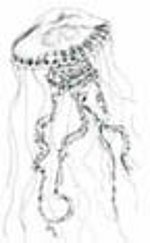Clean Ocean Advocate, December 2004
October’s creature feature was the sea nettle, a common medusa jellyfish in the Middle Atlantic. The sea nettle is typically bell-shaped and pale white, sometimes ribbed with reddish markings that resemble numerous wheels pulsating along the surface; long thin tentacles edge the bell. Each tentacle of a medusa jellyfish has thousands of tiny stinging cells, called nematocysts, which are used to capture food. The sea nettle spends most of its life cycle attached to the underside of oyster shells and other hard surfaces in coastal areas. Small sea slugs or nudibranchs find them irresistible snacks. The sea nettle is familiar to both fishermen and swimmers because of its abundance in the summer and its sting. This past summer, sea nettles were observed in large quantities in Barnegat Bay, raising questions about water quality. For more about sea nettles and jellyfish, visit www.littoralsociety.org/jelly.htm. There were no correct entries.
This month’s creature feature (pictured below) is a fish that is slimy and eel-like. It lives on the bottom of the ocean and NJ fishermen do not “sulk” when catching them in 50-100 feet of water where the ocean floor is rocky. The fish can also be found in soft-bottom habitats. To enter for a chance to win a COA T-shirt, send your guess by mail, fax, or e-mail (PO Box 505, Sandy Hook, NJ 07732; fax 732-872-8041; e-mail SandyHook@CleanOceanAction.org).



